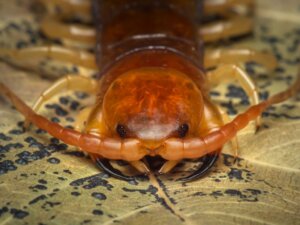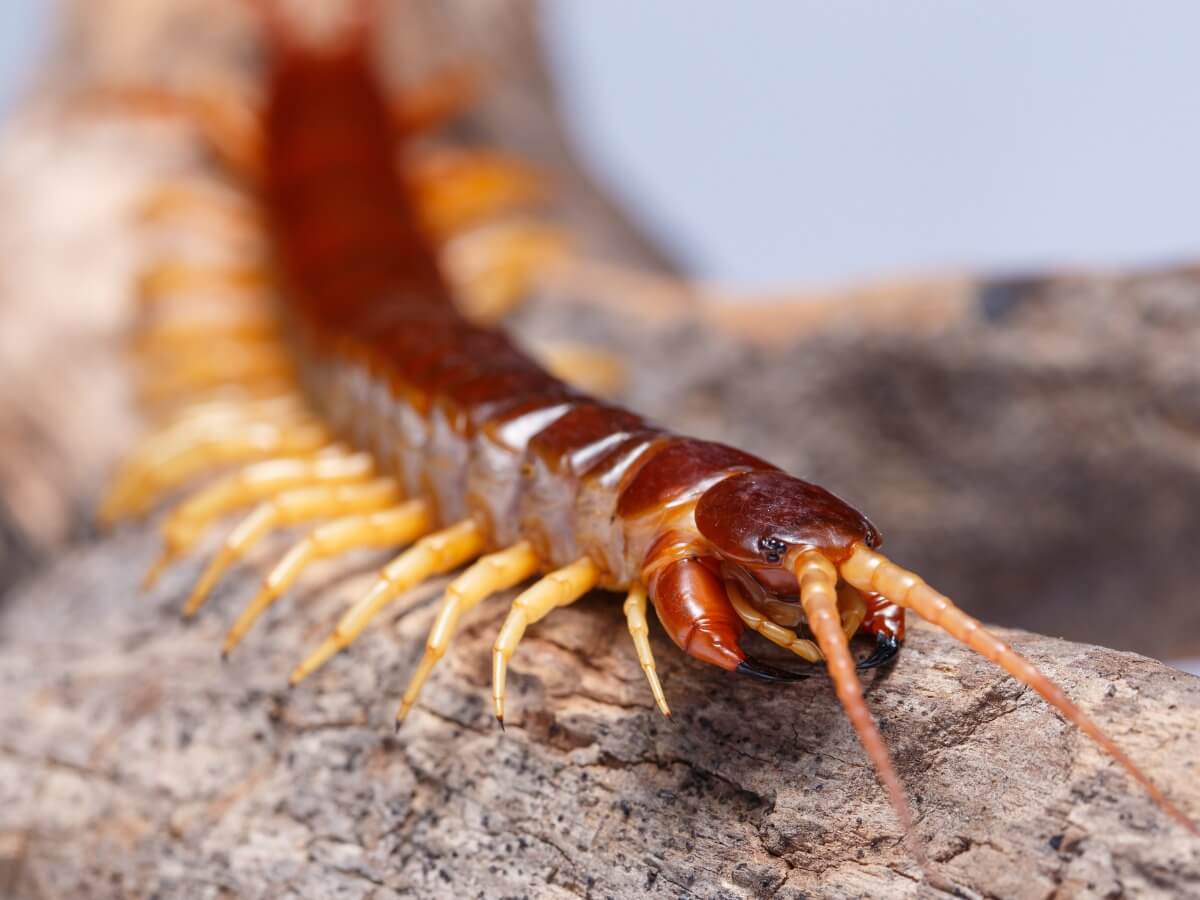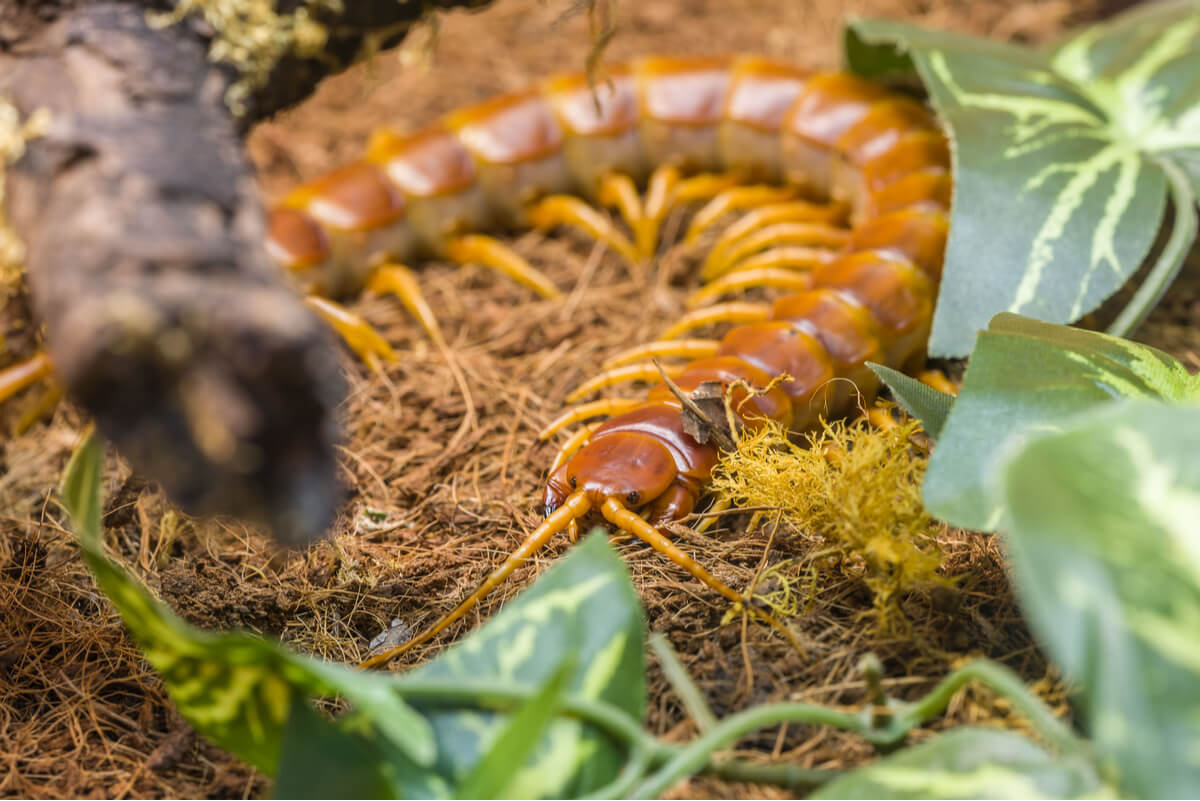10 Curiosities About Centipedes


Written and verified by the biologist Samuel Sanchez
There are many curiosities about centipedes, but, unfortunately, they often go unnoticed by the general public. These beautiful myriapods create quite a negative response in humans, as their elongated size, their unusual number of limbs, and their powerful jaws are quite intimidating. In fact, some species within this group have a very painful and even lethal poison.
Although you should never catch a centipede with your bare hands, if you observe it from afar, you’ll still see that it’s a gift of nature. From their hunting ability to the parental care they exhibit, centipedes won’t leave you indifferent – learn 10 interesting facts about them with us today.
1. Centipedes are related to millipedes
Before going into the curiosities about centipedes as regards their behavior, we’d like to underline some key concepts at a taxonomic level. First of all, we should note that all these animals belong to the phylum of arthropods and to the subphylum Myriapoda, a group that also contains the peaceful relatives with more limbs: millipedes.
In turn, the typical centipedes belong to the Chilopoda class, which also includes the lithobiomorphs, geofilomorphs and scutigeras. All these animals have certain similar characteristics, although they vary in habits and adaptations. Studies estimate that there are more than 8000 species of centipedes in the world, but only about 3000 of them have been discovered.
The order scolopendromorpha represents typical centipede species.
2. Do centipedes have 100 legs?
Despite their name, centipedes have a variable number of limbs depending on the species, which can range from 30 to 354. Interestingly, all these arthropods have an odd number of pairs of legs, making it practically impossible for them to possess just 100 limbs. Scolopendras, the most typical centipedes, have a fixed number of marching legs.
Scolopendras have 21 to 23 pairs of legs, with exceptions.

3. How long can centipedes get?
All centipedes have a number of similar characteristics: a flattened head, a very conspicuous pair of antennae, strong and powerful jaws, and a variable number of body segments (minimum 15), with a pair of walking legs in each section.
Scolopendras are the types of centipedes that first come to mind when talking about this group, but they aren’t the only representatives. Geofilomorphs, for example, are much smaller chilopods with many more legs. The Nannarrup hoffmani species, belonging to the aforementioned taxon, takes the record for being the smallest centipede in the world, at just 1 centimeter in length (0.4 inches).

4. Animals of darkness and moisture
One of the curiosities about centipedes is that their universal habitat is the soil, as long as there are dark and humid recesses. They have colonized a large number of habitats (including dry Mediterranean areas), but they always look for microecosystems with high humidity to rest in. Loss of water is a great danger to them.
Since centipedes don’t have a waxy coating to minimize their water loss, they have to be kept moist to avoid dehydration.
5. Some natural predators
All centipedes are generalist predators. Although it has been observed that they can eat plants when they’re about to starve, the reality is that plant matter constitutes a minimal percentage of their diet. Therefore, they’re considered strict carnivores.
Depending on their size, these arthropods can prey on springtails, isopods, small insects, worms, and even mice and small birds. The most lethal representation of this group is the Scolopendra gigantea, – at more than 30 centimeters (12 inches) in length and with very powerful jaws, it’s capable of hunting even medium-sized snakes.

6. A clinically significant poison
Scolopendras are the most intimidating representatives of the centipede group, as their general size makes them quite dangerous. Most of these species can’t kill a human being with the venom that they inject with their bite, but they can cause intense pain, erythematous edema in the area of the injury, and chronic discomfort that can last for up to 2 weeks.
The poisons of Scolopendra subspinipes and Scolopendra dehaani are particularly dangerous and, unfortunately, have caused occasional sporadic human deaths. According to personal reports, these species cause the most powerful pain that you could possibly experience with their bite.
7. Centipedes and millipedes aren’t the same
Despite being close relatives (both belong to the Chilopoda taxon), centipedes and millipedes have undergone a remarkable evolutionary divergence. This list will help you distinguish between them without a problem:
- Centipedes have one pair of legs on each body segment, while millipedes have two pairs. For this reason, as a general rule, we can establish that millipedes have more limbs, hence their name.
- Millipedes are slow, while centipedes run at unusually fast speeds.
- As we have said in previous lines, centipedes are strict predators. On the other hand, millipedes are considered detritivores, as they feed on decaying plants and other types of organic matter.
- Some millipedes ball or emit foul chemicals to defend themselves against predators, but they’re not poisonous. Centipedes, on the other hand, always resort to stinging and inoculating toxic agents if they can.
8. A very unromantic reproduction
Another of the most relevant curiosities about centipedes is that their reproduction is quite archaic. There’s usually no copulation in most species: the male leaves a spermatophore protected with sperm and the female finds it when she passes by, collecting it and fertilizing herself. In the world of scolopendras, there are no dances, courtships, or bridal gifts.
9. Curiosities about centipedes: they take care of their young
What these arthropods lack in romance they make up for by being good parents. Geofilomorphs and female scolopendras, for example, roll over the eggs and keep them protected, eliminating possible mites and fungi that may emerge on their surface.
The mother remains with the newborn young until they’re able to leave the nest. Some species even exhibit a behavior called matriphagy, in which newly hatched youngsters feed on their mother’s body before going out into the world. Few situations adhere so much to the saying of “giving your life for your children.”
Eggs that aren’t cared for by the mother tend to become infested with fungi and rot.
10. An unknown global situation
As the last of our curiosities about centipedes, we need to point out that the vast majority haven’t been evaluated in terms of their conservation status. This means that it isn’t known if they’re in danger of extinction or not, as their population numbers can’t be calculated nor can special protection programs be established.
For this reason, all of us must do our part and avoid unnecessary altercations with them. If you ever find a centipede at home, sweep it out with a broom without touching it, but don’t kill it. These predators deserve respect and admiration, despite the fact that many people are intimidated by them.
There are many curiosities about centipedes, but, unfortunately, they often go unnoticed by the general public. These beautiful myriapods create quite a negative response in humans, as their elongated size, their unusual number of limbs, and their powerful jaws are quite intimidating. In fact, some species within this group have a very painful and even lethal poison.
Although you should never catch a centipede with your bare hands, if you observe it from afar, you’ll still see that it’s a gift of nature. From their hunting ability to the parental care they exhibit, centipedes won’t leave you indifferent – learn 10 interesting facts about them with us today.
1. Centipedes are related to millipedes
Before going into the curiosities about centipedes as regards their behavior, we’d like to underline some key concepts at a taxonomic level. First of all, we should note that all these animals belong to the phylum of arthropods and to the subphylum Myriapoda, a group that also contains the peaceful relatives with more limbs: millipedes.
In turn, the typical centipedes belong to the Chilopoda class, which also includes the lithobiomorphs, geofilomorphs and scutigeras. All these animals have certain similar characteristics, although they vary in habits and adaptations. Studies estimate that there are more than 8000 species of centipedes in the world, but only about 3000 of them have been discovered.
The order scolopendromorpha represents typical centipede species.
2. Do centipedes have 100 legs?
Despite their name, centipedes have a variable number of limbs depending on the species, which can range from 30 to 354. Interestingly, all these arthropods have an odd number of pairs of legs, making it practically impossible for them to possess just 100 limbs. Scolopendras, the most typical centipedes, have a fixed number of marching legs.
Scolopendras have 21 to 23 pairs of legs, with exceptions.

3. How long can centipedes get?
All centipedes have a number of similar characteristics: a flattened head, a very conspicuous pair of antennae, strong and powerful jaws, and a variable number of body segments (minimum 15), with a pair of walking legs in each section.
Scolopendras are the types of centipedes that first come to mind when talking about this group, but they aren’t the only representatives. Geofilomorphs, for example, are much smaller chilopods with many more legs. The Nannarrup hoffmani species, belonging to the aforementioned taxon, takes the record for being the smallest centipede in the world, at just 1 centimeter in length (0.4 inches).

4. Animals of darkness and moisture
One of the curiosities about centipedes is that their universal habitat is the soil, as long as there are dark and humid recesses. They have colonized a large number of habitats (including dry Mediterranean areas), but they always look for microecosystems with high humidity to rest in. Loss of water is a great danger to them.
Since centipedes don’t have a waxy coating to minimize their water loss, they have to be kept moist to avoid dehydration.
5. Some natural predators
All centipedes are generalist predators. Although it has been observed that they can eat plants when they’re about to starve, the reality is that plant matter constitutes a minimal percentage of their diet. Therefore, they’re considered strict carnivores.
Depending on their size, these arthropods can prey on springtails, isopods, small insects, worms, and even mice and small birds. The most lethal representation of this group is the Scolopendra gigantea, – at more than 30 centimeters (12 inches) in length and with very powerful jaws, it’s capable of hunting even medium-sized snakes.

6. A clinically significant poison
Scolopendras are the most intimidating representatives of the centipede group, as their general size makes them quite dangerous. Most of these species can’t kill a human being with the venom that they inject with their bite, but they can cause intense pain, erythematous edema in the area of the injury, and chronic discomfort that can last for up to 2 weeks.
The poisons of Scolopendra subspinipes and Scolopendra dehaani are particularly dangerous and, unfortunately, have caused occasional sporadic human deaths. According to personal reports, these species cause the most powerful pain that you could possibly experience with their bite.
7. Centipedes and millipedes aren’t the same
Despite being close relatives (both belong to the Chilopoda taxon), centipedes and millipedes have undergone a remarkable evolutionary divergence. This list will help you distinguish between them without a problem:
- Centipedes have one pair of legs on each body segment, while millipedes have two pairs. For this reason, as a general rule, we can establish that millipedes have more limbs, hence their name.
- Millipedes are slow, while centipedes run at unusually fast speeds.
- As we have said in previous lines, centipedes are strict predators. On the other hand, millipedes are considered detritivores, as they feed on decaying plants and other types of organic matter.
- Some millipedes ball or emit foul chemicals to defend themselves against predators, but they’re not poisonous. Centipedes, on the other hand, always resort to stinging and inoculating toxic agents if they can.
8. A very unromantic reproduction
Another of the most relevant curiosities about centipedes is that their reproduction is quite archaic. There’s usually no copulation in most species: the male leaves a spermatophore protected with sperm and the female finds it when she passes by, collecting it and fertilizing herself. In the world of scolopendras, there are no dances, courtships, or bridal gifts.
9. Curiosities about centipedes: they take care of their young
What these arthropods lack in romance they make up for by being good parents. Geofilomorphs and female scolopendras, for example, roll over the eggs and keep them protected, eliminating possible mites and fungi that may emerge on their surface.
The mother remains with the newborn young until they’re able to leave the nest. Some species even exhibit a behavior called matriphagy, in which newly hatched youngsters feed on their mother’s body before going out into the world. Few situations adhere so much to the saying of “giving your life for your children.”
Eggs that aren’t cared for by the mother tend to become infested with fungi and rot.
10. An unknown global situation
As the last of our curiosities about centipedes, we need to point out that the vast majority haven’t been evaluated in terms of their conservation status. This means that it isn’t known if they’re in danger of extinction or not, as their population numbers can’t be calculated nor can special protection programs be established.
For this reason, all of us must do our part and avoid unnecessary altercations with them. If you ever find a centipede at home, sweep it out with a broom without touching it, but don’t kill it. These predators deserve respect and admiration, despite the fact that many people are intimidated by them.
All cited sources were thoroughly reviewed by our team to ensure their quality, reliability, currency, and validity. The bibliography of this article was considered reliable and of academic or scientific accuracy.
- Attems, C. (1930). Scolopendromorpha (pp. 1-287). De Gruyter.
- Cupul-Magaña, F. G. (2014). Los ciempiés escolopendromorfos (Chilopoda: Scolopendromorpha) de México: clave para géneros. Revista Colombiana de Entomología, 40(2), 292-297.
- Zalesskaja, N. T., & Shileyko, A. A. (1990, July). The distribution of Scolopendromorpha in the USSR. In Advances in Myriapodology, Proceedings of the 8th International Congress of Myriapodology, Innsbruck (pp. 15-20).
- González-Sponga, M. A. (2000). Miriapodos de Venezuela: diez nuevas especies del genero Newportia (Chilopoda: Scolopendromorpha: Cryptopidae). Memoria de la Fundación La Salle de Ciencias Naturales, 60(153), 103-122.
- Adis, Joachim; Harvey, Mark S. (2000). “How many Arachnida and Myriapoda are there worldwide and in Amazonia?”. Studies on Neotropical Fauna and Environment. 35 (2): 139–141
This text is provided for informational purposes only and does not replace consultation with a professional. If in doubt, consult your specialist.








